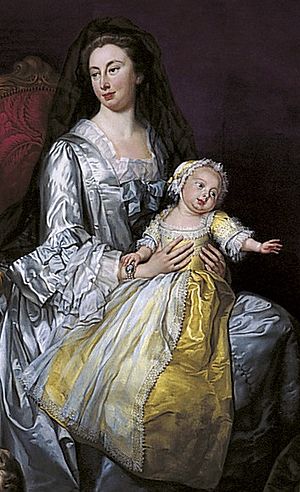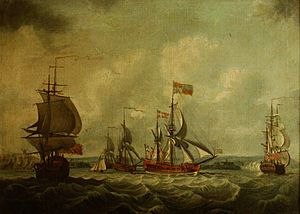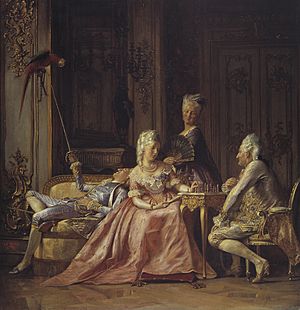Caroline Matilda of Great Britain facts for kids
Quick facts for kids Caroline Matilda of Great Britain |
|
|---|---|
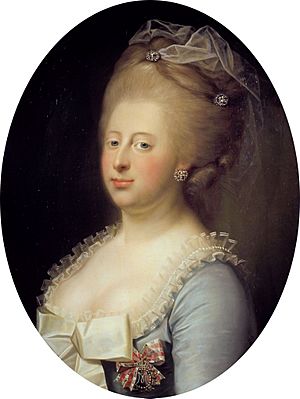
Portrait by Jens Juel, 1771
|
|
| Queen consort of Denmark and Norway | |
| Tenure | 8 November 1766 – April 1772 |
| Coronation | 1 May 1767 |
| Born | 22 July 1751 (New Style) Leicester House, London, England, Great Britain |
| Died | 10 May 1775 (aged 23) Celle, Holy Roman Empire |
| Burial | 13 May 1775 Stadtkirche St. Marien, Celle |
| Spouse | |
| Issue | Frederick VI of Denmark Louise Augusta, Duchess of Schleswig-Holstein-Sonderburg-Augustenburg |
| House | Hanover |
| Father | Frederick, Prince of Wales |
| Mother | Augusta of Saxe-Gotha-Altenburg |
Caroline Matilda of Great Britain (Danish: Caroline Mathilde; 22 July 1751 – 10 May 1775) was the Queen of Denmark and Norway. She became Queen in 1766 when she married King Christian VII.
Caroline Matilda was the youngest daughter of Frederick, Prince of Wales. Her father passed away before she was born. She grew up in a quiet family home, away from the busy royal court. When she was fifteen, she married her cousin, King Christian VII of Denmark and Norway. King Christian faced some health challenges that affected his mind, and he was often distant from his wife. They had two children: Frederick VI, who would become king, and Louise Augusta.
In 1769, a German doctor named Johann Friedrich Struensee started working for the Danish king. At first, Caroline Matilda was not friendly towards him. However, he soon won her trust, and they became very close. Struensee gained a lot of power and started many new rules and changes, which Caroline Matilda supported. These changes and his close relationship with the Queen made powerful enemies. These enemies included Christian VII's stepmother, Queen Dowager Juliana Maria, and her son Prince Frederick. In 1772, Juliana Maria planned to remove Struensee and the Queen from power. Struensee was put to death, and Caroline Matilda's marriage ended. She was sent away to Celle, where she passed away at the age of twenty-three in 1775 from scarlet fever.
Contents
Life of Caroline Matilda
Her Birth and Early Years
Caroline Matilda was born on 22 July 1751. She was the ninth and youngest child of Frederick, Prince of Wales, and Princess Augusta of Saxe-Gotha. Her father had died suddenly about three months before she was born, so she was born after his death. She was born at Leicester House in London. This was a large house where her parents lived because the King had asked his son to leave the royal court in 1737.
The princess was christened, or baptized, ten days after her birth, on 1 August, at the same house. Her godparents were her brother George, her aunt Caroline, and her sister Augusta.
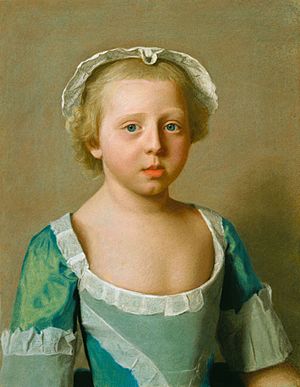
Caroline Matilda grew up with her many brothers and sisters. After her father died, her mother, Augusta, chose to live quietly with her children. She focused on raising them away from the royal court and its bad influences. Because of this, Augusta was sometimes criticized for how she raised her children. She kept them somewhat isolated from the outside world, and they rarely met people outside their family.
Caroline Matilda spent most of her time with her family at Leicester House. During holidays, they would move to Kew Palace. She was described as lively, natural, and informal. As an adult, she was not very interested in politics or court secrets. She loved being outdoors and riding horses. Even though her education was not always traditional, she was considered intelligent. She was also very musical, playing the harpsichord and singing beautifully. She enjoyed reading and could speak three languages besides English: Italian, French, and German.
Her Marriage to the King
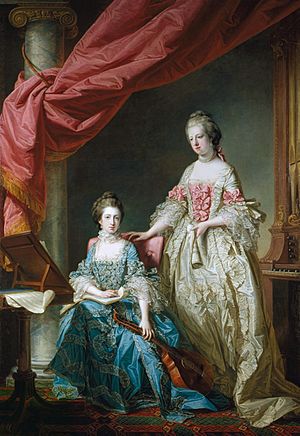
In 1764, a marriage was suggested between the Danish royal family and the British royal family. The idea was for Christian, Crown Prince of Denmark, to marry a British princess. Christian was the oldest son of King Frederick V and his first wife, Princess Louise of Great Britain. This made him a first cousin to Caroline Matilda.
The marriage was a good idea because both royal families were Protestant and had the same high status. Also, the late Queen Louise had been very popular in Denmark. At first, they thought about Princess Louise Anne, Caroline Matilda's older unmarried sister. But the Danish representative in London learned that Princess Louise Anne was not very strong or healthy. So, her younger sister, Caroline Matilda, was chosen instead.
At 13 years old, Caroline Matilda was engaged to Crown Prince Christian, who was two years older than her. She did not know about this engagement beforehand. The official announcement was made on 10 January 1765.
On 14 January 1766, while wedding plans were being made, King Frederick V passed away. His 17-year-old son then became King Christian VII. On 1 October of that year, the wedding took place by proxy in London. This means the groom was not there in person. Caroline Matilda's brother, Prince Edward, Duke of York and Albany, stood in for the King.
Two days later, Caroline Matilda left Harwich for Rotterdam. Three weeks later, she crossed the River Elbe and arrived in Altona, which was then part of Denmark. There, she said goodbye to her British helpers and was welcomed by her new Danish royal staff. Twelve days later, Caroline Matilda arrived in Roskilde, where she met her future husband for the first time.
She made her official entry into the Danish capital on 8 November, and the people cheered loudly. Later that same day, a second wedding ceremony with the King present took place. This was in the Royal Chapel at Christiansborg Palace in Copenhagen. Wedding celebrations and balls continued for another month. On 1 May 1767, Christian VII and Caroline Matilda were crowned King and Queen of Denmark and Norway. This happened in the chapel of Christiansborg Palace.
Queen of Denmark and Norway
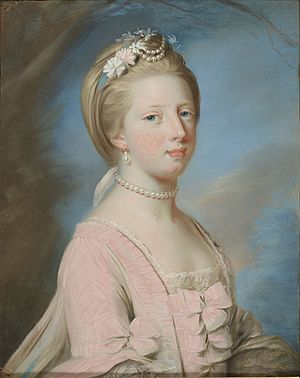
The young Queen at the Danish court was described as very lively and charming. She was thought to be a bit plump to be called a great beauty, but people still found her attractive. They said her looks allowed her to avoid criticism and still catch the eye of men. However, her natural and simple personality was not popular at the very strict Danish court. Even though she was first welcomed warmly in Copenhagen, things changed.
King Christian VII was not strong-willed, was focused on himself, and had health challenges that affected his mind. He was distant from his wife and was not eager to start their life together as husband and wife. One reason for this might have been that the court had forced him to marry. They believed marriage would help his mental problems. Also, some at court felt that Christian VII preferred the company of men over women.
Caroline Matilda became close to her chief lady-in-waiting, Louise von Plessen. Louise thought the King's friends, like Conrad Holck and Enevold Brandt, were bad influences. She tried to keep Caroline Matilda away from her husband. This was not hard, as Christian VII did not seem to like her. The couple grew even more distant when Louise von Plessen told Caroline Matilda to say she wasn't feeling well when the King wanted to be close. Louise thought this distance would make the King more eager, but instead, it only made him more unwilling.
Eventually, after being convinced by his old tutor Reverdil, Christian VII did start his life with Caroline Matilda as husband and wife, for the sake of having an heir. The Queen gave birth to Crown Prince Frederick on 28 January 1768.
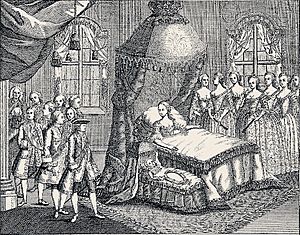
Even though Caroline Matilda was not interested in politics, she became very important at court after her son was born. Her dislike for her husband's friends grew when, in 1768, Holck managed to have Louise von Plessen sent away from court. This left the Queen feeling even more alone. She refused to accept Louise von Plessen's replacement, Anne Sofie von Berckentin. Caroline Matilda suspected Anne Sofie had helped plan Louise's exile. So, a new chief lady-in-waiting was not found until Margrethe von der Lühe agreed to take the job in 1768.
In May 1768, Christian VII went on a long trip around Europe, visiting places like Altona, Paris, and London. While he was away, Caroline Matilda took care of her son. She also caused a stir by taking walks in Copenhagen. This was seen as unusual because royal and noble Danish women usually only traveled in town by carriage. Caroline Matilda spent the summer at Frederiksborg Castle with her son before returning to Copenhagen in the autumn.
During the King's absence, there were rumors about the Queen and a handsome actor and singer named La Tour. La Tour was close to her lady-in-waiting Elisabet von Eyben. But it was known that he received gifts from "a higher hand," and people said his visits to von Eyben's room were actually visits to the Queen. It is not believed that these rumors were true. However, La Tour was sent away after the King returned, perhaps because the rumors themselves caused enough trouble. Besides von Eyben, Caroline Matilda became friends with Christine Sophie von Gähler, Anna Sofie Bülow, and Amalie Sofie Holstein. These women were known for their social lives. According to a letter writer named Luise Gramm, they encouraged Caroline Matilda to join in more social events, dance, and be more outgoing.
Her Marriage Ends and She Leaves Denmark
The questioning of Johann Friedrich Struensee began on 20 February 1772. He did not admit to anything about his close relationship with the Queen for three days. Later, he tried to put much of the blame on Caroline Matilda. Struensee's main political partner and friend, Enevold Brandt, was questioned at the same time. He reportedly admitted what he knew about Struensee's actions. At the same time, the Queen's staff were also questioned. The statements from her chamber staff, especially her head chamber woman Charlotta Hedevig Matthie, her lady's maids, and her chamber maid, were very damaging. Her lady-in-waiting Elisabeth von Eyben also gave important information.
A group of four nobles was sent to Kronborg to question the Queen. During their first visit, Caroline Matilda refused to speak with them. She said she only recognized the King's court. On their later visits, she denied her relationship with Struensee, hoping to save him. On 9 March, a signed confession from Struensee was shown to Caroline Matilda. She also signed a confession and took much of the blame herself. She hoped this would lessen her close friend's punishment, although it is believed she was pressured or tricked into admitting the relationship by the questioner.
On 24 March, a formal accusation against the Queen was presented to a court of thirty-five nobles. On 2 April, she was given a lawyer. The lawyer argued that the Queen was innocent and that her confession was signed under pressure, only to protect Struensee. The decision was made on 6 April, and two days later, the Queen was told: her marriage to Christian VII was ended. Also, the former Queen's name was not allowed to be mentioned during church services. Struensee and Brandt were sentenced to death and were executed on 28 April. Caroline Matilda later said she felt in her heart when her close friend died.
In Great Britain, the news of Caroline Matilda's arrest caused great concern. After her marriage ended, her brother, King George III, ordered Robert Murray Keith to try and get her released. He tried, but it was not successful at first. At the same time, George III had received strong evidence against his sister. He was told she could not stay at the Danish court. After Caroline Matilda's death, it was found that the Danes had offered to send Struensee and his allies away to Aalborg in northern Jutland. But the British government strongly refused this. They even threatened to end diplomatic relations with Denmark-Norway and start a military action. A British naval squadron arrived near Copenhagen. But a few hours before it arrived, George III received news that the Danish government would guarantee the former Queen's freedom. Keith also managed to get her dowry (money she brought into the marriage) back, a pension, and Caroline Matilda's right to keep her royal title.
By May 1772, the British and Danish governments had decided where Caroline Matilda would live. George III suggested that his "Criminal Sister" should live at Celle Castle, in the Electorate of Hanover. On 3 May, the former Queen, along with Keith and a group of Danish nobles, left Helsingør on two ships. Her two children, Crown Prince Frederick and Louise Augusta, stayed in Copenhagen. She never saw them again. On 5 June, she arrived in the district of Stade. The Danish group finally left her there. She was greeted with a grand ceremony, and the next day, a reception was held in her honor. From Stade, the former Queen went to Göhrde, where she stayed for a few months before finally going to Celle. On 20 October, Caroline Matilda made her formal entry into the city. A proper court was set up for her there. After that, she rarely left Celle, only visiting Hanover a few times.
Life in Celle
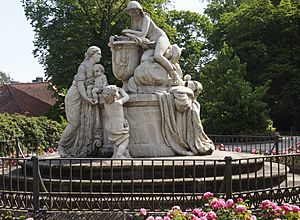
In Celle, Caroline Matilda lived a very quiet life. Here, she was finally reunited with her beloved former chief lady-in-waiting, Countess Louise von Plessen. Many relatives and friends visited the former Queen. Among them was her older sister Augusta, Duchess of Brunswick-Wolfenbüttel. Many people at the time thought this was a way to keep an eye on her.
Her main entertainment was a small theater, built especially for her in the castle. She also had a library with many books in German and English. In addition, she became known for her kindness to poor children and orphans. Keith, who visited Caroline Matilda in November 1772, later told Lord Suffolk that he found her in a happy mood. He said she did not want to have any dealings with the Danish court except those that directly affected her children's well-being.
Even though she was no longer Queen, Caroline Matilda still played an important role in Danish politics. This was because she was the mother of the future King. In September 1774, she was visited by a traveler and adventurer named Nathaniel Wraxall. During this visit, he gathered a lot of information about her life in Denmark. This information later became part of his memories. He returned in October as a secret agent for a group of Danish nobles who wanted change. Some of them were living in Hamburg because they had supported the former Queen. One remained in Copenhagen. They wanted Caroline Matilda to return as the person in charge and guardian of the Crown Prince.
Caroline Matilda was ready to act, but only with her brother George III's approval. She also worried about her children's lives. George III was ready to support his sister and the plan. But he said the plotters first had to gain enough power in Denmark. Wraxall visited the former Queen three more times in Celle and talked with her about the plan's details. Then he went to London to discuss the plan with George III. With him, Caroline Matilda sent a letter to her brother. In it, she asked for his approval for the plan, which she called "this scheme for my son's happiness." However, while waiting to meet the King in London, Wraxall learned that Caroline Matilda had passed away.
Caroline Matilda died suddenly from scarlet fever on 10 May 1775. On her deathbed, she wrote a letter to her brother, saying she was innocent. She was buried in the crypt of the Stadtkirche St. Marien. She rests near her great-grandmother, Sophia Dorothea of Brunswick-Lüneburg, who also had her marriage ended and was sent away.
Great Denmark Street in Dublin is believed to have been named in her honor in the year of her death.
Her Children
| Name | Birth | Death | Notes |
|---|---|---|---|
| King Frederick VI of Denmark | 28 January 1768 | 3 December 1839 | married 1790, Princess Marie of Hesse-Kassel; had children |
| Princess Louise Augusta of Denmark | 7 July 1771 | 13 January 1843 | married 1786, Frederick Christian II, Duke of Schleswig-Holstein-Sonderburg-Augustenburg; had children |
Caroline Matilda in Culture
The story of Caroline Matilda, her marriage, and her close relationship with Struensee has been shown in many artistic works:
Books
- 1827 : Caroline Matilda, to Christian the Seventh of Denmark, a poem by Lydia Sigourney.
- 1935 : The Prisoner of Celle (Die Gefangene von Celle) – a 1935 novel by Else von Hollander-Lossow.
- 1935 : The Favourite of the Queen (Struensee: Doktor, Diktator, Favorit und armer Sünder) – a 1935 novel by Robert Neumann.
- 1948 : The Queen's Physician – a 1948 novel by Edgar Maass.
- 1953 : Converse at Night in Copenhagen (Samtale om natten i København) – a 1953 novel by Karen Blixen.
- 1969 : The Lost Queen – a 1969 novel by Norah Lofts.
- 1999 : The Visit of the Royal Physician (Livläkarens besök) – a 1999 novel by Per Olov Enquist.
Stage Plays and Ballets
- 1827 : Struensee – an 1827 play by Michael Beer with music by his brother Giacomo Meyerbeer.
- 1991 : Caroline Mathilde – a 1991 ballet by the Royal Danish Ballet with music by Sir Peter Maxwell Davies.
- 2008 : The Visit of the Royal Physician (Livlægens besøg) – a 2008 opera by the Royal Danish Opera based on Enquist's 1999 novel.
Movies
- 1923 : The Love of a Queen (Die Liebe einer Königin) – a 1923 German silent film. Caroline Mathilde was played by Henny Porten.
- 1935 : The Dictator – a 1935 British film. Caroline Mathilde was played by Madeleine Carroll.
- 1957 : King in Shadow (Herrscher ohne Krone) – a 1957 West German film. Caroline Mathilde was played by Odile Versois.
- 2012 : A Royal Affair (En kongelig affære) – a 2012 Danish film. Queen Caroline Matilda is played by Alicia Vikander.
See also
 In Spanish: Carolina Matilde de Gran Bretaña para niños
In Spanish: Carolina Matilde de Gran Bretaña para niños


